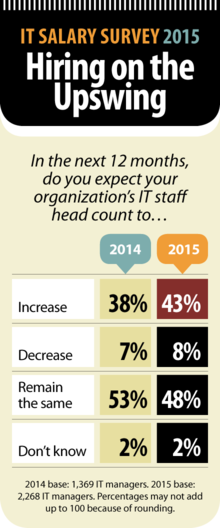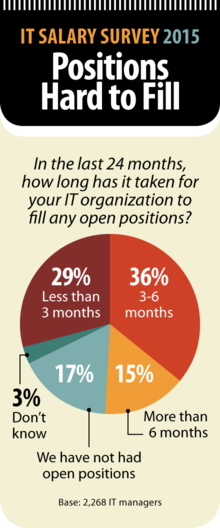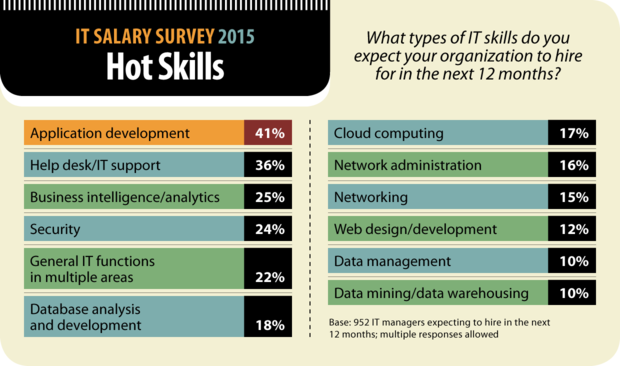In Hot Jobs Market, IT Workers Call the Shots
Computerworld | Apr 27, 2015 3:00 AM PT
By Mary K. Pratt
Like many of his colleagues, MIS director Bill Jones is in the market for IT talent. Jones, who runs the IT department for the city of Port St. Lucie, Fla., needs two developers to fill new positions created to build and maintain a permitting app, plus someone for another new position tasked with installing and maintaining a telephone system.

Despite a positive work environment and good benefits, Jones admits that landing the right people to join his 19-member IT team at the pay the city offers — about $40,000 to $80,000, depending on the position — will be tough.
"I can hire a programmer, but that doesn't mean he can do that job. That just means I can put a body in a chair," he says.
That's a common thought among IT executives today. Unemployment among tech professionals is low, and the number of new IT positions is up. Those factors and an ongoing skills shortage are pushing up salaries, lengthening the time it takes to fill open slots and putting more control in the hands of job seekers.
Consider the findings from Computerworld's 2015 IT Salary Survey: Some 43% of the 2,268 managers polled said they expect to increase IT head count this year, up from 38% in 2014.
However, the pool of potential candidates may not be very big. Of the more than 4,800 IT employees responding to the poll, 48% said they're not looking for a new job, 37% said they're just passively looking for a new job at a different organization and 6% said they're seeking a new job with their current employer. Only 9% said they're actively looking for a new position at a different employer.
That's tough on employers, because the number of technology jobs is growing. Management consulting firm Janco Associates reported in March that more than 130,000 new IT positions had been created in the U.S. in the prior 12 months.
What's more, the unemployment rate for IT workers is currently only around 2.5%, says Jason Hayman, research manager with IT staffing firm TEKsystems.
Given such figures, it's not surprising that it takes employers months to fill positions. Some 36% of the IT managers who responded to the Computerworld survey said it took three to six months to fill open tech positions during the past two years, while 15% reported that it took more than six months.
"Workers have a lot of power at the bargaining table," Hayman says. "They can pick and choose the opportunities they want to take, and they can set their demands for employers."
Chief among those demands is a bigger paycheck. Among Computerworld survey respondents who said they're looking for new jobs, 60% said they're doing so for higher compensation; that was the No. 1 response. And 74% of all respondents (not just those looking for jobs) said a salary increase would most influence them to change jobs, making it the leading reason by far.
Specialists in demand
According to our survey, 64% of those expecting to expand their IT staffs this year plan to hire mostly for highly skilled specialist positions, while 31% want staff or entry-level technical professionals. Only 3% plan to hire mainly for management positions.
Some organizations will have more trouble than others filling open positions, of course. Recruiters and IT leaders say that some regions — namely the tech-centric cities on the East and West coasts as well as urban areas in between — have more open tech positions (and thus more competition for talent) than other locales. And employers seeking to fill jobs in several hot disciplines, including security, big data, the Internet of Things and mobile app development, will have a harder time finding the right candidates.
Yet no one sees a return to the days of the dot-com boom when companies were frantically trying to hire IT professionals. "We're not in a crazy bubble mode, and I'm not worried that there will be one," says James Stranger, senior director of product management at CompTIA, a tech industry group known for its certifications.
Still, he says, there's a gap between the demand for IT professionals and the supply of them, particularly in key areas such as programming, project management and IT support.

Scott Magerfleisch, a network services manager for a municipal agency in Colorado, is well aware of the hurdles he faces as he prepares to replace a retiring tech support worker this fall and, in 2016, add a system administrator to his 14-member team.
Even though Colorado has a "ridiculously low" IT unemployment rate (1.8%, according to staffing firm Upp Technology), Magerfleisch can't start searching for a replacement until the current employee's retirement nears — the budget won't support two paychecks for the same position for very long. The short timeline will be challenging enough, but he also anticipates that candidates will come in with demands because they know they have their pick of opportunities.
Still, he's optimistic that he'll find good candidates — that is, people with enough experience but not so much that they can command the highest pay. He plans to use staffing firms because they will have done the upfront vetting and skills assessment work, and he plans to hire people on a temp-to-permanent basis to ensure they're technically
capable and good cultural fits before adding them to the staff.
"I think having those talent agencies that we can pull from, we can be successful," he says.
Strategies for hiring success
Recruiters and IT leaders say the challenge of landing candidates who have the desired skills and who fit into the organizational culture varies depending on factors such as the timeline for hiring, the geographic reach of the search and the position's compensation package. The higher the pay, the longer the lead time and the broader the search, the better the odds of getting the right fit.
Even when employers can find people with the technology skills they want, they often hold out for candidates who also have broad IT experience, business acumen and soft skills such as communication and collaboration capabilities, says Stranger. He points out that companies of all sizes need that combination because their technology team members usually have cross-functional responsibilities.
But while that strategy can work well when filling conventional IT positions — networking jobs, for example — it often won't work for jobs in hot disciplines such as security and big data, where employees have the upper hand in the labor market, Stranger says.
John Reed, senior executive director of IT staffing firm Robert Half Technology, agrees. "Typically companies have a very specific profile in mind that they're looking for, and the more specific, the more difficult it is for them to find," he says. "It's the same for candidates. Candidates don't want to leave a job for something that's comparable; they want something better."
Reed says most employers and employees eventually find what they're seeking. But there has to be some give. Companies need to ease up on requirements, raise pay and lengthen their search times to land the right people. Many already do all three, he adds.
A worker's perspective
Robert Romig, a Dallas-based IT support specialist at law firm Zelle Hofmann Voelbel & Mason, is well aware that tech workers are in demand but says the strong IT job market doesn't mean he'd quickly land a job he wants.
"If I was to unexpectedly lose my job tomorrow, I could have job offers lined up within two weeks, three weeks at most," Romig says. "But being able to find a job is not the same thing as finding a good job."
Romig isn't looking to move from his current position, but he regularly gets calls from recruiters and staffing firms. But they're not always offering something better. He says finding the right fit — a challenging position with the right compensation in the right environment — would likely take longer than a few weeks because he'd have to sort through postings and eliminate contract and temporary positions as well as ones that would be lateral moves.

Taking the long view
David Lewis is also taking slow and careful approach as he seeks to hire new staffers. The vice president and CIO at Deseret Mutual Benefits Administrators in Salt Lake City, Lewis plans to add two programmers to his 35-member IT team to help develop applications needed to address the growing complexity, workload and government regulations facing his company.
He says he competes with other local employers as well as Silicon Valley companies, making it more difficult to find the right people. So he's looking long term, taking more time to find candidates who have the technical aptitude and a cultural fit with his IT shop so they'll want to stay and thrive.
"It's the soft skills that differentiate between an OK candidate and a great candidate," he says, adding that he wants people who "work hard and work smart." To ensure that he finds such people, Lewis brought on two college interns to train and ultimately, he hopes, hire after they graduate.
But his long-term thinking doesn't end there. Lewis says IT leaders have to look at high school students and encourage more of them — particularly women, who are traditionally under-represented in the field — to get into IT. That, he says, is what will guarantee that hiring won't be a problem in years to come.

